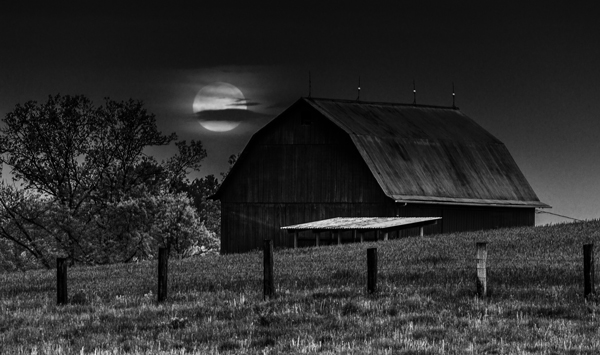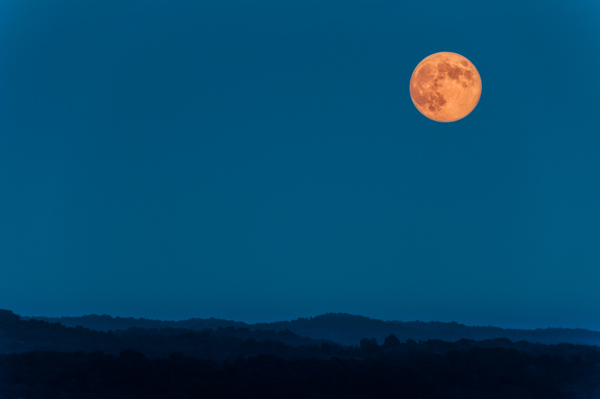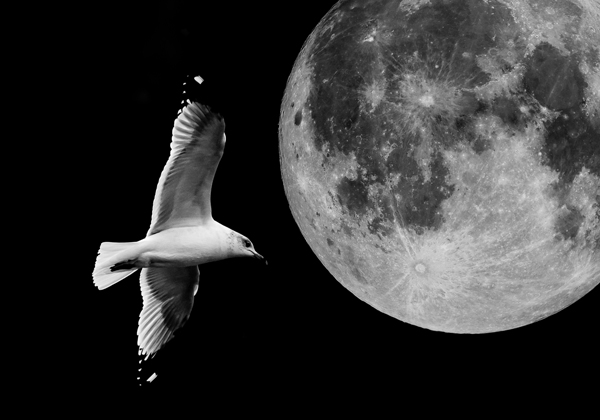The post 20 Dos and Don’ts for Shooting the Moon appeared first on Digital Photography School. It was authored by Bruce Wunderlich.

If you’ve ever tried shooting the moon, you’ve probably discovered that it’s actually a pretty tricky subject!
But don’t worry; there are some tips and techniques you can use to quickly improve your moon photography.
In this article, let’s look at some dos and don’ts to take your moon images from snapshots to stunning art.

1. Do use a tripod
One of the most important pieces of equipment for shooting the moon is a good tripod.
Since the moon is so small, it is very important to have a sturdy foundation, because even the most minute movement of the camera will cause your image to blur.
You might think that, if you use a fast-enough shutter speed, you can handhold the camera. But since your subject is so small in the frame, even small movements will be exaggerated.
2. Don’t use a slow shutter speed
While it’s a good idea to use a tripod, you must avoid using a slow shutter speed.
Why?
Because the moon is actually moving very quickly around the earth. The moon is so distant, it doesn’t appear to be traveling very fast. But if you let your shutter speed relax too much, you’ll end up with all sorts of unwanted motion blur.
A good rule of thumb for tack-sharp moon photography is to shoot at 1/125s or faster.
3. Do use a telephoto lens
To successfully capture any kind of detail on the moon, you need at least a 300mm telephoto lens.
If you want the moon to take up the entire frame, you will need around an 800mm lens.

4. Don’t use any filters on your lens
To prevent any chance of a blurry image, don’t use any filters.
Yes, even remove the UV filter. This may sound scary if you never remove the UV filter from your lens, but in this case, it’s best to set it aside.
Some may suggest using a neutral density (ND) filter for moon photography to cut back on the bright light of the moon. But all this will do is require a slower shutter speed, and you want to use the fastest shutter speed possible to get that crisp, tack-sharp image.
5. Do try the Looney 11 Rule
The Looney 11 Rule is similar to the Sunny 16 Rule. It’s designed to help you exposure properly when shooting the moon, while also ensuring you get a fast-enough shutter speed for sharp shots.
Here’s how it works:
Set your f-stop to f/11.
Then match the shutter speed to your ISO.
For example, if your ISO is set at 200, set your shutter speed to 1/200s.
(This is not an exact science, but it should give you a good starting point.)
6. Don’t use the shutter button to start your exposure
Do not manually press the shutter button or even touch your tripod when initiating your moon shot.
Remember that even the slightest touch could add enough vibration to blur the image.
Instead, use a cable release or remote trigger to start your exposure. If you don’t have either of these gadgets, use the self-timer feature on your camera.
7. Do use mirror lock-up
If you’re working with a DSLR and it has the option, lock up your mirror. This can greatly increase your chances of getting a tack-sharp moon image.
You see, even the slightest shake of your camera’s mirror can be enough to blur the shot. So if your camera has this option, use it!
Lock the mirror up and wait a few seconds to allow any vibrations to settle before beginning your exposure.
(If your camera doesn’t have a mirror lock-up option, you can always shoot in Live View, which will have the same effect!)
8. Don’t use image stabilization
Your lens’s (and camera’s) image stabilization technology must be turned off as soon as you put your camera on a tripod.
Turning on an image stabilization feature with your camera mounted on a tripod will actually create blur in your image!
9. Do know the cycles of the moon

There are 29.5 days between full moons.
And by learning when the full moon will come, you can ensure you get the best-looking moon in your shots!
There are many online and smartphone applications that can help you track the phases of the moon. One must-have app is The Photographer’s Ephemeris, which will give you the phases of the moon, and also show you when and where the moon will appear in the sky.
This is especially useful when planning your moon shoots. The full moon is very popular and photogenic, but it’s also the brightest and the most difficult to expose correctly.
The side lighting of a gibbous moon produces some interesting shadows which may allow you to capture craters and mountains. The crescent moon is, of course, the darkest stage, but one that may offer some interesting effects when added to a nighttime landscape.
10. Don’t always place the moon in the center of the frame
Putting the moon in the center of the frame – especially if there’s nothing else in the shot – is boring.
It’s been done a million times before. So try to put the moon off-center.
Oh, and make sure to include other interesting objects in the frame!
That’s how you’ll end up with a truly impressive moon photo.

11. Do switch to manual focus
There are a couple of different methods you can use to focus on the moon.
First, try using your camera’s autofocus to make the moon tack sharp. Then, once you have a desirable point of focus, turn off the autofocus and switch to manual focus.
Alternatively, you can start by setting your lens to manual focus. With your camera’s Live View feature turned on, zoom in on the moon and turn the manual focus ring until the moon becomes sharp. Then do not touch the ring again.
12. Don’t just shoot the moon at night
The best time to photograph the moon is just after it rises or just before it sets, when it’s low in the sky.
Why is this important?
For one, when the moon is near the horizon, it will appear larger in your images (due to a trick of the eye).
Also, as the full moon rises, the sun will be setting, and as the full moon sets, the sun will be rising. This can give you great lighting to accentuate foreground objects.
Note that shooting the moon in the daytime (e.g., in the late afternoon) will give you the opportunity to include foreground objects, and you may also be able to capture some craters on the moon’s surface.

13. Do use exposure bracketing
Once you have found an exposure that you’re happy with, it’s best to bracket around that setting.
You see, the view of your images in the dark, on the back of your camera, can often be deceiving. In the dark, images always appear brighter on the camera LCD than they are when opened on your computer.
So after you’re satisfied with the exposure you have dialed in, bracket two stops under and two stops over, just to ensure that you get a result you’ll be happy with later.
14. Don’t use Auto White Balance
Using Auto White Balance will give you very inconsistent results.
Instead, I recommend you try the daylight white balance preset. And if you’re looking for a different effect, try the tungsten or cloudy presets.
Don’t be afraid to experiment.
And remember:
If you are shooting in RAW, you can change the white balance in post-production.
15. Don’t depend on your meter
In general, your camera’s light meter will be fooled by the amount of light reflecting off the moon.
So make sure you constantly check your LCD and histogram to ensure you’ve nailed the exposure.
Also, it is important to note that, as the moon rises, the exposure will change. The moon gets brighter as it rises, so you’ll need to keep adjusting your shutter speed to compensate.
16. Do shoot the moon in RAW
Shooting in RAW will allow you to capture more details of the moon’s surface, and also give you more latitude for adjustments in Lightroom and Photoshop.
So, unless you are not at all comfortable with using camera RAW software, always shoot the moon in RAW.
17. Don’t be afraid to crop your images
Unless you are shooting with a very large telephoto lens, you will want to crop your image to display the moon at a decent size.
But remember:
The more you crop, the more you reduce your ability to print at a high resolution.
18. Do tweak and sharpen
Most moon photography is going to require some post-processing in Photoshop or other photo editing software. Adding clarity and contrast will help bring out details, and this will enhance the craters and mountains of the moon.
As mentioned above, the white balance and exposure may also be adjusted to achieve a nice result, as both are somewhat difficult to perfect in-camera.
19. Don’t be afraid to get creative
Here’s the truth:
Most great moon photography has been manipulated in post-production, because of the difficulty of capturing a great moon shot in one image.
So don’t be afraid to get creative.
For instance, you might create a composite, as I did for this image:

A popular method used by many photographers is to combine two exposures: one set to bring out the best of the foreground landscape, and a second exposed for the moon.
When combining these two images, try enlarging the moon slightly to achieve a more dramatic effect, but don’t overdo it to the point that it looks fake. The moon needs to look believable, unless you are going for a science fiction effect (which isn’t always a bad idea, creatively speaking!).

20. Do practice, practice, practice
You now know everything you need to get started with moon photography.
So get out there and shoot the moon!
Remember that moon photography is not as easy as it looks, so if your first results are not as dramatic as you expected, then keep trying!
Now I’d like to see some of your moon images! Please share any moon shots in the comments below.
The post 20 Dos and Don’ts for Shooting the Moon appeared first on Digital Photography School. It was authored by Bruce Wunderlich.
































You must be logged in to post a comment.